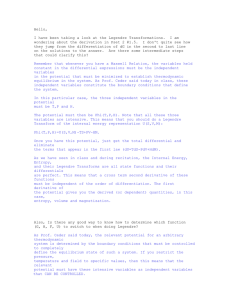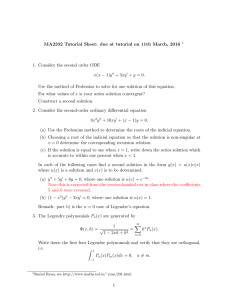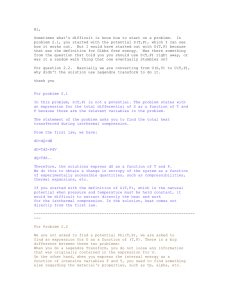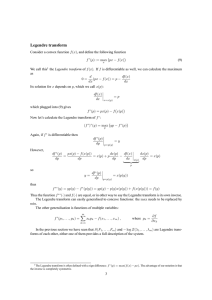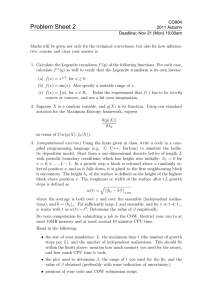Representation of a dissimilarity matrix using reticulograms
advertisement
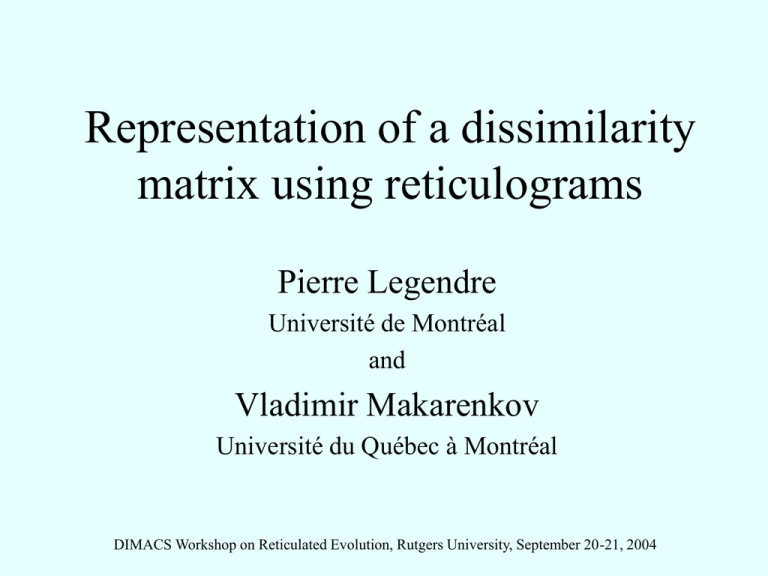
Representation of a dissimilarity
matrix using reticulograms
Pierre Legendre
Université de Montréal
and
Vladimir Makarenkov
Université du Québec à Montréal
DIMACS Workshop on Reticulated Evolution, Rutgers University, September 20-21, 2004
The neo-Darwinian tree-like
consensus about the evolution
of life on Earth
(Doolittle 1999, Fig. 2).
The neo-Darwinian tree-like
consensus about the evolution
of life on Earth
(Doolittle 1999, Fig. 2).
A reticulated tree which might
more appropriately represent the
evolution of life on Earth
(Doolittle 1999, Fig. 3).
Reticulated patterns in nature
at different spatio-temporal scales
Evolution
1. Lateral gene transfer (LGT) in bacterial evolution.
2. Evolution through allopolyploidy in groups of plants.
3. Microevolution within species: gene exchange among populations.
4. Hybridization between related species.
5. Homoplasy, which produces non-phylogenetic similarity, may be
represented by reticulations added to a phylogenetic tree.
Non-phylogenetic questions
6. Host-parasite relationships with host transfer.
7. Vicariance and dispersal biogeography.
Reticulogram, or reticulated network
Root
Diagram representing an evolutionary
structure in which the species may be
related in non-unique ways to a common
ancestor.
A reticulogram R is a triplet (N, B, l) such
that:
• N is a set of nodes (taxa, e.g. species);
• B is a set of branches;
x
l(i,x)
i
• l is a function of branch lengths that assign
real nonnegative numbers to the branches.
Each node is either a present-day taxon
belonging to a set X or an intermediate node
belonging to N – X.
l(x,y)
y
j
Set of present-day taxa X
Reticulogram distance matrix R = {rij}
The reticulogram distance rij is the minimum path-length distance
between nodes i and j in the reticulogram:
rij = min {lp(i,j) | p is a path from i to j in the reticulogram}
Problem
Construct a connected reticulated network, having a fixed number of
branches, which best represents, according to least squares (LS), a
dissimilarity matrix D among taxa. Minimize the LS function Q:
Q = ∑i X ∑j X (dij – rij)2
min
with the following constraints:
• rij ≥ 0 for all pairs i, j X;
• R = {rij} is associated with a reticulogram R having k branches.
Root
Method
• Begin with a phylogenetic tree
T inferred for the dissimilarity
matrix D by some appropriate
method.
y
• Add reticulation branches, such
as the branch xy, to that tree.
l(x,y)
x
i
j
How to find a reticulated branch xy to add to T, such that its length l
contributes the most to reducing the LS function Q?
j
Solution
y
l
1. Find a first branch xy to add to the tree
• Try all possible branches in turn:
x
...
i
Recompute distances among taxa X in the presence of branch xy;
Compute Q = ∑i X ∑j X (dij – rij)2 incl. the candidate branch xy;
• Keep the new branch xy, of length l(x,y), for which Q is minimum.
2. Repeat for new branches.
STOP when the minimum of a stopping criterion is reached.
Stopping criteria
d ij – rij
2
Q
j ---X------------------------------ = ---------------- X----------Q 1 = -----i---------------------n n – 1
n n – 1
---------------------- – N
---------------------- – N
2
2
• n(n–1)/2 is the number of distances
among n taxa
• N is the number of branches in the
unrooted reticulogram
For initial unrooted binary tree: N = 2n–3
d ij – rij
2
Q
i X j X
AIC = --------------------------------------------------------- = --------------------------------------------------------- 2n – 2 2n – 3
2n – 2 2n – 3
-------------------------------------------- – 2N
-------------------------------------------- – 2N
2
2
(2n–2)(2n–3)/2 is the
number of branches in a
completely interconnected,
unrooted graph containing
n taxa and (2n–2) nodes
AIC: Akaike Information Criterion; MDL: Minimum Description Length.
Properties
1. The reticulation distance satisfies the triangular inequality, but not
the four-point condition.
2. Our heuristic algorithm requires O(kn4) operations to add k
reticulations to a classical phylogenetic tree with n leaves (taxa).
Simulations
to test the capacity of our algorithm to correctly detect reticulations
when present in the data.
Generation of distance matrix
Method inspired from the approach used by Pruzansky, Tversky and
Carroll (1982) to compare additive (or phylogenetic) tree
reconstruction methods.
• Generate additive tree with random topology and random branch
lengths.
• Add a random number of reticulations, each one of randomly chosen
length, and located at random positions in the tree.
• In some simulations, add random errors to the reticulated distances,
to obtain matrix D.
Tree reconstruction algorithms to estimate the additive tree
1. ADDTREE by Sattath and Tversky (1977).
2. Neighbor joining (NJ) by Saitou and Nei (1987).
3. Weighted least-squares (MW) by Makarenkov and Leclerc (1999).
Criteria for estimating goodness-of-fit
1. Proportion of variance of D accounted for by R:
2. Goodness of fit Q1, which takes into account the least-squares loss
(numerator) and the number of degrees of freedom (denominator):
Simulation results (1)
1. Type 1 error
• Random trees without reticulation and without random error: no
reticulation branches were added to the trees.
• Random trees without reticulation but with random error: the
algorithm sometimes added reticulations to the trees. Their number
increased with increasing n and with the amount of noise s2 = {0.1,
0.25, 0.5}. Reticulations represent incompatibilities due to the noise.
2. Reticulated distance R
The reticulogram always represented the variance of D better than the
non-reticulated additive tree, and offered a better adjustment (criterion
Q1) for all tree reconstruction methods (ADDTREE, NJ, MW), matrix
sizes (n), and amounts of noise s2 = {0.0, 0.1, 0.25, 0.5}.
Simulation results (2)
3. Tree reconstruction methods and reticulogram
The closer the additive tree was to D, the closer was also the
reticulogram (criterion Q1). It is important to use a good tree
reconstruction method before adding reticulations to the additive tree.
4. Tree reconstruction methods
MW (Method of Weights, Makarenkov and Leclerc 1999) generally
produced trees closer to D than the other two methods (criterion Q1).
Application 1: Homoplasy in phylogenetic tree of primates1
Data: A portion of the protein-coding mitochondrial DNA (898 bases)
of 12 primate species, from Hayasaka et al. (1988).
Distance matrix: Hamming distances among species.
1Example
developed in Makarenkov and Legendre (2000).
1. A phylogenetic tree was constructed from D using the neighborjoining method (NJ). It separated the primates into 4 groups.
2. Five reticulations were added to the tree (stopping criterion Q1).
Prosimii
(Lemurs, tarsiers and lorises)
Lemur
catta Tarsius
syrichta
Cercopithecoidea
(Old World monkeys)
Macaca
fascicularis
Macaca
fusca ta
Macaca
sylvanus
17
22
19
Saimirisciureus
18
21
Macaca
mulatta
Ceboidea
(New World monkeys)
20
16
The reticulations reflect
homoplasy in the data.
Reduction of Q after 5
reticulations: 30%
Hylobates
Hominoidea
(Apes and man)
Homo
sapiens
15
14
13
Pan
Pongo
Gorilla
Application 2: Postglacial
dispersal of freshwater
fishes1
Camin-Sokal tree
with reticulations
1
Question: Can we reconstruct
the routes taken by freshwater
fishes to reinvade the Québec
peninsula after the last
glaciation?
2
23
12
24
15
14
3
26 27
13
30
29
25
32
33
17
28
4
20
The Laurentian glacier melted
away between –14000 and –
5000 years.
31
18
5
34
16
19
35
7
21
8
37
36
9
38
41
6
40
39
10
11
42
1Example
developed in Legendre and
Makarenkov (2002).
ROOT
CONICAL PROJECTION
0
0
50 100 150 200
50
100
KILOMETRES
150
200
MILES
Data: Presence-absence of 85 freshwater fish species in 289
geographic units (1 degree x 1 degree). A Sørensen similarity matrix
was computed among units, based on fish presence-absence data. The
289 units were grouped into 21 regions by clustering under constraint
of spatial contiguity (Legendre and Legendre 1984).
Tree: A phylogenetic tree was computed (Camin-Sokal parsimony),
depicting the loss of species from the glacial refugia on their way the
21 regions (Legendre 1986)2.
Reticulogram: New edges were added to the tree using a weighted
least-squares version of the algorithm. Weights were 1 for adjacent, or
0 for non-adjacent regions. Q1 criterion: 9 reticulations were added.
2 Legendre,
P. 1986. Reconstructing biogeographic history using phylogenetic-tree analysis of
community structure. Systematic Zoology 35: 68-80.
Camin-Sokal tree
with reticulations
Biogeographic interpretation
of the reticulations
1
2
23
12
24
15
14
3
26 27
13
30
29
25
32
33
17
28
4
20
31
18
5
34
16
19
35
7
21
8
37
36
9
38
41
6
40
39
10
11
42
ROOT
CONICAL PROJECTION
0
0
50 100 150 200
50
100
KILOMETRES
150
200
MILES
The reticulations added to the
tree represent faunal
exchanges by fish migration
between geographically
adjacent regions using
interconnexions of the river
network, in addition to the
main exchanges described by
the additive tree.
Application 3: Evolution of photosynthetic organisms1
Compare reticulogram to splits graph.
Data: LogDet distances among 8 species of photosynthetic organisms,
computed from 920 bases from the 16S rRNA of the chloroplasts
(sequence data from Lockhart et al. 1993).
1
2
3
4
5
6
1. Tobacco
0.0000
2. Rice
0.0258
0.0000
3. Liverworth
0.0248
0.0357
0.0000
4. Chlamydomonas
5. Chlorella
0.1124
0.0713
0.1215
0.0804
0.1014
0.0604
0.0000
0.0920
0.0000
6. Euglena
0.1270
0.1361
0.1161
0.1506
0.1033
0.0000
7. Cyanobacterium
8. Chrysophyte
0.1299
0.1370
0.1390
0.1461
0.1190
0.1261
0.1535
0.1606
0.1128
0.1133
0.1611
0.1442
1Example
developed in Makarenkov and Legendre (2004).
7
8
0.0000
0.1427
0.0000
Splits graph
Euglena H
Chl a+b
0.0671
0.0142
Chrysophyte H
Chl a+c
Cyanobacterium
0.0745
0.0629
Chrysophyte H
0.0777
14
0.0093
58%
0.0087
Chlorella H
Chl a+b
0.0805
13
Chlamydomonas
0.01297
0.0035
0.0678
0.0238
Cyanobacterium
Chl a
87%
0.0728
12
0.1285
63%
0.0033
0.0255
Liverworth
Chl a+b
0.0070
Tobacco
Chl a+b
0.0002
0.0680
Chlamydomonas
Chl a+b
0.0025
11
0.0333
Chlorella H
0.0008
0.1352
0.0298
0.0104
0.0075
Reticulogram
Euglena H
0.1529
0.0175
Rice
Chl a+b
100%
10 100%
0.0143
9
0.0089
Tobacco
0.0106
Liverworth
0.0193
Rice
Interpretation of the splits
• Separation of organisms with or without chlorophyll b.
• Separation of facultative heterotrophs (H) from the other organisms.
Interpretation of the reticulations
• Group of facultative heterotrophs.
• Endosymbiosis hypothesis: chloroplasts could be derived from
primitive cyanobacteria living as symbionts in eukaryotic cells.
Application 4: Phylogeny of honeybees1
Data: Hamming distances among 6 species of honeybees, computed
from DNA sequences (677 bases) data. D from Huson (1998).
Phylogenetic tree reconstruction method: Neighbor joining (NJ).
1Example
developed in Makarenkov, Legendre and Desdevises (2004).
Application 5: Microgeographic differentiation in muskrats1
The morphological differentiation among local populations of
muskrats in La Houille River (Belgium) was explained by “isolation
by distance along corridors” (Le Boulengé, Legendre et al. 1996).
Data: Mahalanobis distances among 9 local populations, based on 10
age-adjusted linear measurements of the skulls. Total: 144 individuals.
Populations C
C
E
J
L
M
N
O
T
Z
0.0000
2.1380
2.2713
1.7135
1.5460
2.6979
2.9985
2.3859
2.3107
1Example
E
J
L
M
N
O
T
0.0000
2.9579
2.3927
1.9818
3.3566
3.6848
2.3169
2.3648
0.0000
1.7772
2.4575
1.9900
3.4484
2.4666
1.8086
0.0000
1.0125
1.8520
2.4272
1.4545
1.6609
0.0000
2.6954
2.6816
1.7581
2.0516
0.0000
2.3108
2.2105
2.2954
0.0000
2.5041
3.4301
0.0000
2.0413
developed in Legendre and Makarenkov (2002).
Z
0.0000
Tree: The river network of La Houille.
4 reticulations were added to the tree (minimum of criterion Q2).
Interpretation of O-N, M-Z, M-10: migrations across wetlands. N-J =?
References
Available in PDF at http://www.fas.umontreal.ca/biol/legendre/reprints/
and http://www.info.uqam.ca/~makarenv/trex.html
Legendre, P. (Guest Editor) 2000. Special section on reticulate
evolution. Journal of Classification 17: 153-195.
Legendre, P. and V. Makarenkov. 2002. Reconstruction of
biogeographic and evolutionary networks using reticulograms.
Systematic Biology 51: 199-216.
Makarenkov, V. and P. Legendre. 2000. Improving the additive tree
representation of a dissimilarity matrix using reticulations. In: Data
Analysis, Classification, and Related Methods. Proceedings of the
IFCS-2000 Conference, Namur, Belgium, 11-14 July 2000.
Makarenkov, V. and P. Legendre. 2004. From a phylogenetic tree to a
reticulated network. Journal of Computational Biology 11: 195-212.
Makarenkov, V., P. Legendre and Y. Desdevises. 2004. Modelling
phylogenetic relationships using reticulated networks. Zoologica
T-Rex — Tree and Reticulogram Reconstruction1
Downloadable from http://www.info.uqam.ca/~makarenv/trex.html
Authors: Vladimir Makarenkov
Versions: Windows 9x/NT/2000/XP and Macintosh
With contributions from A. Boc, P. Casgrain, A. B.
Diallo, O. Gascuel, A. Guénoche, P.-A. Landry, F.-J.
Lapointe, B. Leclerc, and P. Legendre.
Methods implemented
• 6 fast distance-based methods for additive tree reconstruction.
________
Makarenkov, V. 2001. T-REX: reconstructing and visualizing phylogenetic trees
and reticulation networks. Bioinformatics 17: 664-668.
1
• Reticulogram construction, weighted or not.
• 4 methods of tree reconstruction for incomplete data.
• Reticulogram with detection of reticulate evolution processes,
hybridization, or recombination events.
• Reticulogram with detection of horizontal gene transfer among
species.
• Graphical representations: hierarchical, axial, or radial. Interactive
manipulation of trees and reticulograms.
